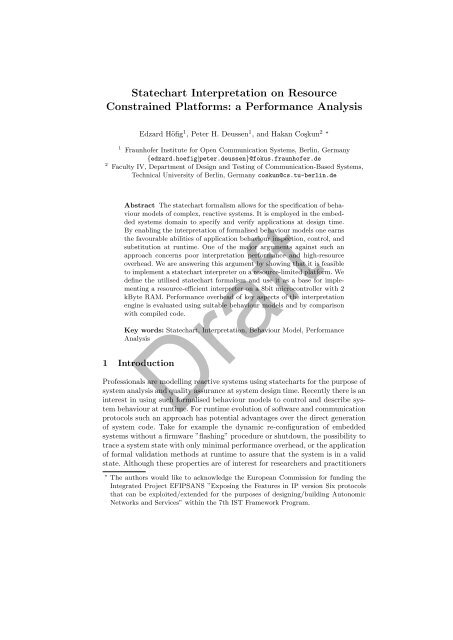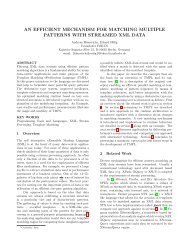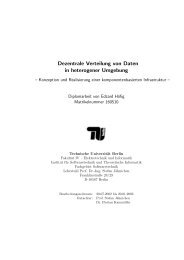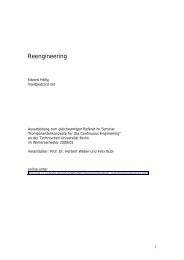Download a draft version of the paper
Download a draft version of the paper
Download a draft version of the paper
You also want an ePaper? Increase the reach of your titles
YUMPU automatically turns print PDFs into web optimized ePapers that Google loves.
In our current work we use statecharts for network and system management[7] with <strong>the</strong> goal <strong>of</strong> equipping network routers with <strong>the</strong> ability to make autonomicdecisions on an incoming packet stream by interpreting behaviour models [8]. Wealso have prior experience with optimisation <strong>of</strong> Extended Finite State Machines(EFSM) based automatons for analysing large XML data streams [9] and some <strong>of</strong><strong>the</strong> optimisations that we are employing were discovered during previous work.3 Formal Definition <strong>of</strong> StatechartsOur formalism follows <strong>the</strong> definition specified in <strong>the</strong> annex <strong>of</strong> <strong>the</strong> original research<strong>paper</strong> [1]. We left out <strong>the</strong> “History Connector” definition, but apart fromthat we have a full-fledged statechart, including aggregate states and parallelcomponents.We define a higraph as a structure H = S, E, s 0 ,θ,σ, whereS is a finite set<strong>of</strong> symbolic states, E ⊆ S ×S is a set <strong>of</strong> edges, σ : S → 2 2S is a substate function,and s 0 ∈ S is a root state. We call each set <strong>of</strong> states Q ∈ σ(s) acomponent <strong>of</strong>s. Distinguished components Q 1 ,Q 2 ∈ σ(s) are called parallel to each o<strong>the</strong>r. Astate s ∈ S is called atomic if σ(s) =∅ does hold, o<strong>the</strong>rwise it is called composed.Moreover θ : Θ → S assigns a unique start state to each component <strong>of</strong> H, whereΘ = defs∈Sσ(s) is <strong>the</strong> set <strong>of</strong> components <strong>of</strong> H. We assume that θ(Q) ∈ Q foreach Q ∈ Θ, i. e., <strong>the</strong> initial state <strong>of</strong> a component is a member <strong>of</strong> that component.We stipulate a number <strong>of</strong> restrictions; to this end, let us define σ + (s) tobe<strong>the</strong> smallest set (w. r. t. ⊆) <strong>of</strong> symbolic states satisfying Q∈σ(s) Q ⊆ σ+ (s) ands ∈ σ + (s) ⇒ Q∈σ(s ) Q ⊆ σ+ (s).Then we assume that:1. Q ∈ σ(s) ⇒ Q = ∅, i. e., substates <strong>of</strong> s are non-empty sets (note that thisdoes not imply that σ(s) =∅, i. e., we allow atomic states).2. σ is non-cyclic, i.e.,s/∈ σ + (s) for all s ∈ S.3. The sets in σ(s) are pairwise disjoint, i. e., Q 1 ,Q 2 ∈ σ(s) ∧ Q 1 ∩ Q 1 = ∅ ⇒Q 1 = Q 2 , for all s ∈ S such that Q 1 ,Q 2 ∈ σ(s);4. that <strong>the</strong> whole higraph has a tree-like structure, i.e., σ ∗ (s 1 ) ∩ σ ∗ (s 1 ) = ∅ ⇒s 1 ∈ σ ∗ (s 2 ) ∨ s 2 ∈ σ ∗ (s 1 ).5. Finally, for <strong>the</strong> root state s 0 we assume that σ ∗ (s 0 )=S, and s 0 is <strong>the</strong> onlystate with this property.DraftFor <strong>the</strong> sake <strong>of</strong> notational simplicity we moreover define σ −1 (s) = def s whenevers ∈ σ(s ) (note that <strong>the</strong> expression σ −1 (s) is undefined for s = s 0 ).Next, we define a statechart as a structure C = H, V, D, I, ι, ω, γ, α, suchthat H = S, E, s 0 ,θ,σ, is a higraph called <strong>the</strong> skeleton <strong>of</strong> C. V is a finite set<strong>of</strong> variables, D is a set <strong>of</strong> data, I is a set <strong>of</strong> events including <strong>the</strong> empty event, ι, ω : E → I are mappings assigning a triggering event ι(e) and an outputevent ω(e) to each edge <strong>of</strong> H, respectively. Moreover γ : E → (V D →{0, 1})assigns a predicate to each edge <strong>of</strong> H. Here, V D denotes <strong>the</strong> set <strong>of</strong> total mappingsfrom V to D, i. e. all assignments <strong>of</strong> values from D to variables from V . Finally
4.1 The Behaviour ModelWe abstained from defining a syntax for behaviour models and work directly withan Abstract Syntax Tree (AST) in-memory representation, which we supposecan be generated from any suitable representation format (e.g., UML2 statediagrams, or SCXML). For each model <strong>the</strong> complete AST data is allocated as asingle chunk <strong>of</strong> memory and <strong>the</strong> AST structure is constructed with single-bytereferences to this data. Prior to interpretation, an additional executor structureis allocated that holds input and output event queues, as well as data structuresfor processing parallel components, and a reference to s 0 as <strong>the</strong> initial startingpoint for execution.4.2 States and Data SpaceWe restrict S to contain up to 256 symbols encoded by <strong>the</strong> numbers 0..255. Eachstate is represented by a data structure containing fields that allow to bidirectionallynavigate <strong>the</strong> substate tree spanned by σ. For performance reasons weseparate <strong>the</strong> state data structure into a substate set, a set <strong>of</strong> parallel components,and an additional reference to a superstate. Additionally, <strong>the</strong> structure containsa set <strong>of</strong> references to outgoing edges and a so-called flag byte used to indicatestate properties, e.g., θ is implemented as a single bit in <strong>the</strong> flag byte. Sets aregenerally implemented as byte arrays with an additional field that holds set size.For aggregated states, and states containing parallel components, it is necessaryto evaluate θ to identify <strong>the</strong> start state <strong>of</strong> contained component(s), and to additionallycreate data structures that allow for pseudo-concurrent processing <strong>of</strong>parallel components.The variables V are limited to a maximum <strong>of</strong> 246 read- and writeable entriesper behaviour model and 10 additional global entries shared between all executingmodels. Variables are referenced by <strong>the</strong> numerical values 0..255, where <strong>the</strong>values 0..9 refer to global values and 10..255 refer to local ones. The data set Dis limited to 8 bit integer numbers. There is no type system. When data valuesare evaluated within boolean expressions, we follow C conventions for assigninglogical values: 0 corresponds to a logical “false”, o<strong>the</strong>r values are “true”.4.3 Edges and Event ProcessingDraftE is implemented as a set <strong>of</strong> data structures, which contain a reference to adestination state, <strong>the</strong> triggering event assignment ι, and <strong>the</strong> output event assignmentω. There can be a maximum <strong>of</strong> 256 edges. Events are numbered from0..255 and identified by <strong>the</strong>ir numerical value – 0 is <strong>the</strong> special “empty” eventsymbol ε. The edge structure also contains references to a guard condition predicateγ and an action mapping α. Due to parallel processing <strong>of</strong> edges it is possiblefor multiple events to be received during a single step <strong>of</strong> a model. Events arebuffered for input and output in ring-buffers, limited to 10 elements.The guard condition predicates γ need to be evaluated to decide if an edge should
e traversed (hence <strong>the</strong> name “guard condition”). They are specified within <strong>the</strong>model AST and can be constructed from variable or constant references (notationallydepicted using a $ sign), boolean operators (!, ∧, ∨), and comparisonoperators (=, , ≤, ≥). Evaluation precedence is implicitly given through<strong>the</strong> AST hierarchy.The action bindings α are implemented as code that is statically bound to <strong>the</strong>runtime mechanism before <strong>the</strong> interpretation <strong>of</strong> a behaviour model commences.An action binding is a conventional function call with an arbitrary number <strong>of</strong>input and output parameters, and represents fixed capabilities <strong>of</strong> a device thatare orchestrated using statechart logic. It is implemented by a structure holdinga function pointer plus an ordered set <strong>of</strong> variable references. Parameters need tobe de-referenced inside <strong>of</strong> <strong>the</strong> action function and can be used to read or write<strong>the</strong> variable value. A specific set <strong>of</strong> actions considers timers. We created threetimers that can be set with a delay value using set timer(id,delay ) to deliver<strong>the</strong> specific events 8..10 once <strong>the</strong> delay time passes. Timers can be cleared usingclear timer(id ) which suppresses dispatching <strong>of</strong> <strong>the</strong> timer event.Explaining <strong>the</strong> processing algorithm goes beyond <strong>the</strong> scope <strong>of</strong> this <strong>paper</strong>. For anunderstanding <strong>of</strong> <strong>the</strong> intricacies refer to <strong>the</strong> <strong>paper</strong> by J. Ebert [4]. In a nutshell:For each input event all active components in a statechart are evaluated fortriggered edges. If a triggered edge has a matching guard condition, <strong>the</strong> assignedaction is executed and an output event send. The state(s) are <strong>the</strong>n changed andano<strong>the</strong>r evaluation iteration is run with <strong>the</strong> next input event. These steps arerepeated until all active components reach end states. It is worth mentioningthat all ε edges are traversed before <strong>the</strong> next input event is taken from <strong>the</strong> inputqueue. Also, specific handling functionality needs to be executed on entering andexiting parallel states to maintain data structures for active components.5 Performance AnalysisDraftWe found that <strong>the</strong> experimental platform has sufficient resources for <strong>the</strong> statechartinterpreter code, which uses less than 8 KBytes <strong>of</strong> Flash memory. In thissection we describe <strong>the</strong> evaluation results using <strong>the</strong> experimental platform.Latency measurements have been conducted using in-line timestamps, <strong>the</strong> slightdelay that has been introduced by this is negligible for <strong>the</strong> overall result. The employedtimestamping mechanism has an accuracy <strong>of</strong> approx. 4 µs. Stack memorymeasurements were conducted by dumping <strong>the</strong> stack pointer during runtime.Performance <strong>of</strong> <strong>the</strong>se routines is uncritical as such experiments only measuredmemory consumption, not latency.5.1 Memory OverheadTo analyse stack performance, we exercised <strong>the</strong> behaviour model shown in Fig.1. We used <strong>the</strong> following sequence to measure <strong>the</strong> normalised 4 stack allocationas shown in Fig. 2: key ← false, door open, door close, lock, door open,4 Showing only <strong>the</strong> additional bytes consumed during interpretation <strong>of</strong> <strong>the</strong> model
door close, key ← true, lock, door open, key ← false, unlock, door open,key ← true, unlock, door open, door close, wait for <strong>the</strong> lights to turn <strong>of</strong>f. Theinterpreter executes a single step method to iteratively advance <strong>the</strong> statechart.This method uses 25 bytes stack when processing input events and 23 byteswhen processing ε events. Peaks in <strong>the</strong> stack usage are due to evaluation <strong>of</strong> <strong>the</strong>key guard conditions on <strong>the</strong> edges between <strong>the</strong> Locked and Unlocked states.Allocation (bytes)5040302010Evaluation <strong>of</strong> conditional expressionsWaiting for timeoutStack used by step execution method00 100 200 300 400 500 600Number <strong>of</strong> stack samples (~time)Figure 2. Stack usage during interpretation <strong>of</strong> Light & Door model5.2 Conditional Expression Evaluation5.3 Simple Edge Matchingto deliver result.Draft<strong>the</strong> sameThe expression evaluator is implemented as a tree walker that recursively traversesa binary tree <strong>of</strong> statement tokens (variables, constants, and operators).We used three expressions to measure performance “$0 < 15” (interpreted in 24µs), “($0 < 15) ∧ ($1 = $2)” (56 µs), and “(($0 < 15) ∧ ($1 = $2)) ∧ ((30 >$4) ∨ ($3 = $5))” (116 µs). This approach has a remarkable performance overhead:A hard-coded C <strong>version</strong> <strong>of</strong> any <strong>of</strong> <strong>the</strong>se expressions executes in less than4 µs. As seen in Fig. 2 <strong>the</strong> evaluation <strong>of</strong> conditional expressions is depicted aspeaks in <strong>the</strong> stack usage. By sampling stack size during evaluation we found that<strong>the</strong> expression evaluator uses an additional 11 bytes per recursive iteration, e.g.,Expression C uses a total <strong>of</strong> 44 bytes stack memory during evaluation.We are measuring <strong>the</strong> time that our implementation needs to react with a singleoutput event to a single input event using <strong>the</strong> traversal <strong>of</strong> a single edge. Therecan be more than one outgoing edge assigned to a single state, so we are alsointerested in <strong>the</strong> latency <strong>of</strong> <strong>the</strong> interpreter when processing multiple edges. Weare using 30 behaviour models with an increasing number <strong>of</strong> edges for a singlestate. Each edge is triggered by a specific event 1..30 and sends a correspondingoutput event 101..130. Each model is <strong>the</strong>n supplied with exactly one event,activating <strong>the</strong> edge that is triggered by <strong>the</strong> highest event. This is done to force<strong>the</strong> interpreter into exhibiting worst-case behaviour (it checks each edge beforefinding <strong>the</strong> edge that matches). The results, along with an illustration <strong>of</strong> <strong>the</strong>experimental models, can be seen in Fig. 3. To put <strong>the</strong> measurements into perspective,we also added <strong>the</strong> time that a conventional “switch” statement needs
Delay [!s]200160Interpreter1208040"switch" statement00 5 10 15 20 2530e n ! e 100 + nTest...e 1! e 101 e2 ! e 102Number <strong>of</strong> Transitions For a Single StateExperimental ModelsFigure 3. Delay <strong>of</strong> edge matching processesThe latency for a simple edge transition is approx. 64 µs,whichincludeseventprocessing, timer handling, edge selection, and edge execution. It is approximatelya factor 10 slower than a conventional switch statement which executes ataround 6 µs. Latency increases linearly with approx. 3 µs for each edge up to152 µs for 30 edges. The “switch” statement has a constant delay independent<strong>of</strong> <strong>the</strong> given event. The reason for <strong>the</strong> linear increase is <strong>the</strong> need to check each<strong>of</strong> <strong>the</strong> edges for a possible match.The usage <strong>of</strong> dynamic action bindings instead <strong>of</strong> static function calls also has animpact on <strong>the</strong> latency <strong>of</strong> action execution due to <strong>the</strong> way parameters are passedto function code. We created models that trigger an action using a single edgefrom a single state and altered <strong>the</strong> number <strong>of</strong> parameters (0..10) passed to <strong>the</strong>action. The additional delay introduced amounts to an average <strong>of</strong> approx. 3 µsper additional parameter. For conventional function calls we believe that an additionaldelay exists as well, but we found that <strong>the</strong> measured latency differencesare within <strong>the</strong> precision range <strong>of</strong> <strong>the</strong> employed timing mechanism for <strong>the</strong> number<strong>of</strong> arguments studied (delay differs < 4 µs).Draft5.4 Processing <strong>of</strong> Aggregates and Parallel ComponentsThe two major features that differentiate statecharts from EFSM are aggregationand <strong>the</strong> ability to specify parallel components. To measure performance <strong>of</strong>aggregation handling we used a series <strong>of</strong> models with an increasing number <strong>of</strong>nested states (from a single state to an aggregate with a nesting depth <strong>of</strong> 30)where <strong>the</strong> most deeply nested state had an edge that matched on a given inputevent. The parallel component processing was analysed using 30 models whichcontained a superstate with an increasing number <strong>of</strong> parallel components, eachtriggering on <strong>the</strong> same input event. The results are displayed along with <strong>the</strong>experimental models in Fig. 4. We found it necessary to differentiate between<strong>the</strong> first input event and subsequent events 5 processed in <strong>the</strong> same state. This isdue to additional functionality executed when entering an aggregated state or astate that contains parallel components. Fig. 4(A) shows an average delay <strong>of</strong> 12.55 in <strong>the</strong> diagram labelled as 2 nd event, representative for all subsequent events
µs per additional nested state for an event that triggers entering <strong>the</strong> aggregate.Once <strong>the</strong> aggregate has been entered, <strong>the</strong> delay for processing subsequent eventsis independent <strong>of</strong> <strong>the</strong> nesting level. This is different for parallel components, asshown in Fig. 4(B). Entering a state with parallel components has an averagelatency <strong>of</strong> approx. 52 µs per parallel component. There is an average overhead<strong>of</strong> approx. 26 µs per active component for each subsequent event. To compare<strong>the</strong> latency overhead with conventional constructs, we also show <strong>the</strong> delay <strong>of</strong> a“for-loop” sequentially processing <strong>the</strong> input event. In this case, <strong>the</strong> overhead isat approx. 2 µs per additional iteration.4501600Delay [!s]3002001001 st Event00 5 10 15 20 25Delay [μs](A) Depth <strong>of</strong> sub-state containment...Teste n ! e 100 + n2 nd Event301200Experimental Modelsfor Aggregates8004001 st Event00 5 10 15 20 252 nd Event"for loop" statement(B) Number <strong>of</strong> Parallel Componentse 1 !e 101e 2 !e 102TestTeste n ! Teste 100 + n...30ExperimentalModels for ParallelComponentsFigure 4. Event delay characteristics for processing <strong>of</strong> aggregated states (A) and parallelcomponents (B) with <strong>the</strong> employed experimental models6 ConclusionDraftThe results confirm our initial assumption: It is possible to implement a statechartinterpreter on a severely resource-constrained platform. We had no problemfitting <strong>the</strong> interpreter into non-volatile memory, though <strong>the</strong> available heapmemory establishes clear constraints on <strong>the</strong> complexity <strong>of</strong> <strong>the</strong> behaviour models.Heap memory was large enough to hold any <strong>of</strong> <strong>the</strong> experimental models weapplied for performance assessment, but we found that models with about 100states are <strong>the</strong> limit. Stack memory is unlikely to be exhausted: Models wouldneed to use a very deep conditional expression token tree.On <strong>the</strong> performance side, we found that <strong>the</strong> interpreter clearly adds a processingoverhead. In <strong>the</strong> best case execution latency is about a factor 10 longer than withcompiled code. Performance depends largely on <strong>the</strong> structure <strong>of</strong> <strong>the</strong> interpreted
models, main factors are: <strong>the</strong> number <strong>of</strong> edges leaving a state, <strong>the</strong> nesting depthfor aggregates, <strong>the</strong> number <strong>of</strong> parallel components, and <strong>the</strong> usage <strong>of</strong> guard conditions.Also, <strong>the</strong> ratio between <strong>the</strong> time <strong>the</strong> interpreter spends in action functionsand <strong>the</strong> time spent in statechart interpretation plays an important role: If actionfunctions are sufficiently complex, <strong>the</strong> overhead caused by <strong>the</strong> statechart engineis much smaller. On <strong>the</strong> o<strong>the</strong>r hand, if system behaviour is completely modelledusing a statechart, <strong>the</strong> interpretation overhead becomes very large.The interpreter performance can still be improved, mainly by using a betterexpression evaluator, but also by optimisation <strong>of</strong> <strong>the</strong> edge evaluation code (e.g.,grouping triggering events, combining guard conditions). Even with ingeniousoptimisations, some overhead cannot be purged: In <strong>the</strong> worst case, any statechartinterpreter needs to evaluate all outgoing edges for a single state, including <strong>the</strong>outgoing edges <strong>of</strong> parent states, and <strong>the</strong>re will always be an overhead for eventprocessing and handling aggregates, as well as parallel components. Thereforewe conclude that our approach is adequate for reactive systems, which are idlemost <strong>of</strong> <strong>the</strong> time. It does not seem to be suitable for systems that need <strong>the</strong>fastest possible reaction time due to <strong>the</strong> introduced interpretation delay, whichcan easily amount to 1 ms. Such a value is unacceptable for most real-timeapplications. Regarding high-throughput systems, successful applications shouldbe possible but will depend on <strong>the</strong> underlying platform performance and <strong>the</strong>utilised behaviour model complexity.References1. Harel, D.: On visual formalisms. Communications <strong>of</strong> <strong>the</strong> ACM 31(5) (May 1988)2. Gnesi, S., Mazzanti, F.: On <strong>the</strong> fly model checking <strong>of</strong> communicating uml statemachines. ACIS Int. Conf. on S<strong>of</strong>tware Engineering Research, Management andApplications (2004) 331–3383. Raghunathan, B., Hartrum, T.: The automated transformation <strong>of</strong> statecharts froma formal specification to object-oriented s<strong>of</strong>tware. 48th Midwest Symposium onCircuits and Systems (2005) 319– 3224. Ebert, J.: Efficient interpretation <strong>of</strong> state charts. Fundamentals <strong>of</strong> ComputationTheory 710 (Jan 1993) 212–2215. Sánchez, M., Barrero, I., Villalobos, J., Deridder, D.: An execution platform forextensible runtime models. Proc. models@run.time workshop (2008) 107–1166. W3C: State Chart XML (SCXML): State machine notation for control abstraction.http://www.w3.org/TR/scxml/7. Höfig, E., P.H.Deussen: Document-based network and system management. Proc.2nd International Conference on Autonomic Computing and Communication Systems(Jun 2008)8. Höfig, E., Coskun, H.: Intrinsic monitoring using behaviour models in ipv6 networks.to be presented at <strong>the</strong> IEEE Modelling Autonomic Communication Environments(MACE) Workshop (October 2009)9. Hinnerichs, A., Höfig, E.: An efficient mechanism for matching multiple patternson xml streams. Proc. IASTED Int. Conf. on S<strong>of</strong>tware Engineering (2007) 164–170Draft





